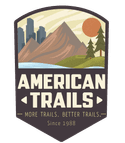This presentation describes how mobile maintenance "strike teams" utilizing packable hand tools can enhance single-track trail maintenance.
This presentation describes how mobile maintenance "strike teams" utilizing packable hand tools can enhance single-track trail maintenance. It discusses user examples showing how mobile teams improve the quality of trails and trail maintenance. The session will highlight stories and examples from different trail organizations around the country, illustrating their use of mobile maintenance teams doing continuous trail maintenance.
Learning Objectives
- Learn about mobile maintenance tools and techniques.
- Through real examples learn how others have implemented a continuous maintenance program using mobile maintenance with packable trail maintenance tools.
- See examples of the positive impact mobile maintenance teams have on single-track trail systems and the paid staff and/or volunteer groups maintaining them.
Questions and Answers from the Webinar
Rachel Nyenhuis asks Bill: What brands do you recommend for long-handled packable tools? I have not heard of these before.
Bill: We make Trail Boss tools, so my answer is pretty much slanted towards our own products. I have not seen others, we seem to more-or-less be a category of one as far as long-handled digging tools go. At least ones that can collapse-down to be short-enough to carry easily in a backpack. There are plenty of folding saws out in the world from Corona, Fiskars, etc. I think the leading saw brands are Silky and Samurai, both Japanese brands. Fiskars makes the killer loppers in the presentation.
What alternatives from e-Bikes have been explored to get tools transported? Do any of groups have the ability to access stock support or backcountry cabins or caches through the land managers they are working with?
Bill: I’ve seen Shimano-powered bikes (like the one in Art’s slide), as well as Specialized Levo, and Giant bikes on trail work parties. The best use seems to be with trailers attached, they can carry a lot. Beware though on longer treks to the worksite, they’re terrible when the battery dies and you don’t have a spare (or forgot to charge the spare, maybe).
Jeff Darling asks Bill: Any favorite tool recommendations?
Bill: We all chimed in about Rogue. Fiskars also makes nice light durable stuff too. I’m partial to Trail Boss (ha ha, small joke given my job).
Patrick Demmons asks Bill: The Mobile Trail Crew concept is interesting, but has anyone else expressed concerns about having unsupervised crews "freelancing" and creating bootleg/illegal MTB DH courses on public lands using agency provided tools?
Bill: I really like this question because I think it’s one we all have asked. First, unsanctioned trails happen with or without mobile crews, although it’s easy to think how setting this up could be an enabler. But I think the truth is those who are part of an official mobile crew, one set up together with the land managers, sees their responsibility to only do sanctioned work, and takes it very seriously. That’s been my experience anyway.
Wendy McDonald asks Bill: Is the inventory of equipment shared with more than one trail? It may be $$ to purchase enough for a large crew/day.
Bill: I think this question may be better for the other panelists. But the packable tools are not exactly for “large” volunteer days. They’re more appropriate for the dedicated and experienced folks who can be part of a mobile maintenance team.
Dave: This is an example of the MORE annual waiver dated a few years ago. The wording has not changed. It is a standard release of liability type waiver.
Debbie Briscoe states: Liking the eastern perspective, specially would like to see more on north east.
What are the favorite brands of multi-head packable tools? What is considered a light weight tool, weight range?
Dave: Trailboss is the most durable, so it has become the standard within MORE.
Todd and Frank: Trailboss tools are the only packable, lightweight, multi-head, tools that I would trust to use. Inteletool is another brand that has multiple heads, and collapses down. But, I prefer the design of the Trailboss more. The Trailboss handle segments can be as short as 12”, compared to 30” for the Inteletool. The Inteletool heads are also larger than and not as packable as the Trailboss heads.
Richard Galloway asks Dave: Can Dave Magill discuss the way they log what needs done on the trails in more detail please?
Dave: each trail liaison develops their own task list for their park. A commonly used app is Avenza Maps, which allows you to create maps with embedded pins, notes and photos. I also mentioned we allow active volunteers to log their own trail work hours (with review/approval from a board member). We currently use Track it Forward but there are several decent apps for this, including Golden Volunteer.
John Trontis comments: Mobile crew members should be identifiable so the public knows that the work of these staff members and/or volunteers is authorized.
Dave: A handful of our larger counties have “trail ranger” programs where they authorize people to do individual or small group work. For the most part they do not provide a badge or card etc., but that would certainly be possible.
John Trontis asks Todd: How do not-for-profit groups satisfy public agency restrictions on using chainsaws and other power tools on public lands? Is there "certified" training provided? How about insurance requirements for same?
Dave: MORE’s liability insurance specifically includes the use of power tools by volunteers.
Todd and Frank: Every land manager has different requirements. MORE works with 12 different agencies, and each one has their own regulations. Some may require you to be USFS certified for bucking and limbing (Blue card), and have a current First Aid certification. Others, may offer their own certification, or training. While others may simply “trust” that you are certified since you are working as a representative of MORE. Our club carries liability insurance, and has long standing relationships with the various land managers. We have a lot of latitude for these reasons. But, we always make sure we are working within the guidelines so we don’t jeopardize those relationships.
Bill: For our organization we have all our sawyers USFS certified. We don’t need certs for power brushers or weed whackers on most lands. We do have some trail segments on city park land, and they don’t allow non-union volunteers to use power tools, per union contract.
Laura Ball asks Todd and Frank: How do you ensure quality work of crews? Issues with "rogue" trail building?
Dave: MORE’s mobile ad hoc trail work program is limited to maintenance and excludes reroutes. New trails or reroutes must be approved by the land manager.
Todd and Frank: Rouge trail building will always happen. We haven’t found a way to eliminate it completely. We have found that if you work with the land managers to provide the riding experience rouge builders are looking for, we can greatly reduce the amount of illegal trails being built.
As for quality of work by our crews, all of our Mobile Trail Crews are experienced volunteers, or have attended a trail work seminar offered by the club, in addition to multiple trail work sessions. We’ve brought IMBA Trail Solutions in on a couple occasions for Trail Summits. These summits have served as a Trail Liaison training ground. Tips and techniques are also shared by our more experienced liaisons who act as mentors to the new generation coming up through the club. We also have an annual Liaison dinner where guest speakers can talk about projects, tools, techniques, and mentoring opportunities.
Travis Ewart asks Todd: What pack do you recommend for basic travel bags/builders?
Todd and Frank: I have a Dakine Builders pack that is great for hauling a wide variety of tools, including a chainsaw pocket. A bunch of us actually have that pack. My other “dedicated” trail tool bag is a Camelbak pack made for backcountry skiing called the Havok (discontinued). It’s smaller than the Builders pack, but, larger than something like the Camelbak HOG. I can easily fit mini loppers, my 3 section Trailboss tool with a couple heads, a folding Corona saw, and a Fiskars brush cutter. You can do a LOT of different projects with those tools.
Bill: I personally like EVOC’s Trail Builder pack. Dakine also makes a nice one. The EVOC is a bit slimmer and packs-down more when only carrying a few tools. I know one builder who likes the Dakine better because its shorter for her smaller torso.
Ryan BalFour states: Another more fun option to the bob trailer is the Surly Big Fat Dummy. Great gearing, load carrying and fun to ride.
Bill: But you’re a manimal and can ride that thing uphill fully loaded faster than I can pedal without tools.
Emily Merlino asks: What brand are these packable tools? Is there a recommended brand/characteristics to look for quality?
Bill: Trail Boss tools are the blue-ish ones. Feel free to hit me up with questions separately. [email protected]. Durability is #1, light-weight and functional are tied for #2.
Ernest Rodrigues asks: Does use of packable tools reduce the likelihood of leaving tools on the trail? Fewer tools, less loss.
Todd and Frank: Yes. Mainly because the mobile crews are small, and each person owns their tool. People are more responsible for their tools when the have some money invested in them. The Builders pack, but, larger than something like the Camelbak HOG. I can easily fit mini loppers, my 3 section Trailboss tool with a couple heads, a folding Corona saw, and a Fiskars brush cutter. You can do a LOT of different projects with those tools.
Bill: My experience with our customers is “yes”. But don’t leave them in the back of your pickup truck in a public place, not for very long anyway.
Patrick Pevey asks Ben: Average weight for the packable tools? Average weight for packable tools kit? Ballpark cost?
Bill: My EVOC pack, loaded up for a ½-day session weighs about 15lbs. That’s with a handle, 2 or 3 heads, loppers, lunch, water. If I’m mostly riding and just doing a little work, a short handle and head adds about 3.5lbs to my pack.
Derek Ryder asks: Have folks considered asking for specific permission for e-bike use for maintenance only?
Bill: Here is Bellingham we’ve discussed it, but not pushed it. Our land managers don’t want to encourage e-mtb use when they’re generally banned from their trails.
Ben Marcus asks: What would be your first steps in creating a volunteer type group/team to assist with trail maintenance?
Dave: if Ben is a land manager, I would suggest starting with asking your most active trail users. Also see if there is an organized hiking or biking group that uses your trails and approach the leadership.
Trail Competencies
-
Relevant Trail Types
General. All trail types are relevant.
Learning Credits and CEUs

Learning credits will be available to attendees and are included in the registration fee. The length of the session will determine the number of hours/credits given. In order to obtain credits, attendees must fill out an evaluation survey for each session they attend, as well as complete a learning credit tracking form noting each session they are requesting credits for (or a quiz if virtual). This form (and complete instructions) will be available online as well at registration. Email the conference host or [email protected] with any questions.
American Trails is a certified provider and can offer the following learning credits and continuing education opportunities: AICP CM, LA CES (most HSW approved), NRPA CEU Equivalency Petition, and CEU/PDH Equivalency Petition for other accepting organizations.
You may also like
Related Upcoming Trainings
No related trainings
This training has been viewed 407 times.
